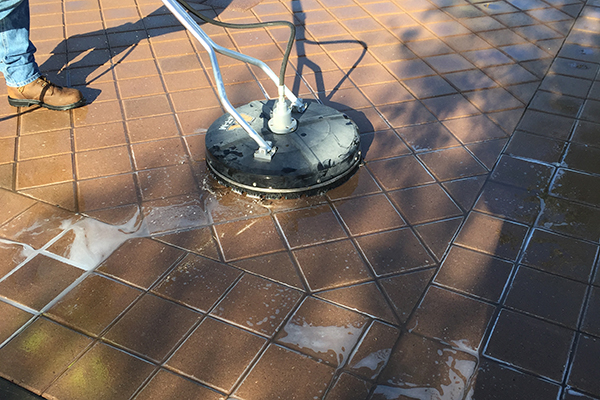Tips for Cleaning Success

With proper care and maintenance, a surface investment can last a lifetime. If there are surface repairs to be made, they should be completed prior to cleaning and sealing. To ensure cleaning success is achieved and the surface maintains its original beauty, here are some important steps to follow.
Prepare Surface for Cleaning
Remove all furniture, potted plants and equipment that stand in the way of being able to clean the surface underneath. Sweep and remove all loose soil and debris from the surface. Protect adjacent and surrounding surfaces not intended to be cleaned as well as nearby plants and shrubs.
Check the Temperature
Best cleaning results are obtained when air and surface temperatures are 40°F and above. Do not clean when temperatures are below freezing or will be overnight. If the surface is frozen, allow adequate time for the surface to thaw. If temperatures exceed 90°F, flash cool the surface with water before applying a cleaner. Unlike with sealing, some cleaning can be performed on days that experience some light rain.
Establish a Cleaning Strategy
Inspect area for visible staining to determine stain types and quantity. Determine appropriate cleaners and tools needed to accomplish the job.
Perform a Pre-Test
Before using any specialty cleaners or an overall multi-use cleaner, perform a pre-test on a small, inconspicuous area of the surface to be cleaned. This will help determine if the right cleaner was selected and what is the appropriate dilution rate and correct dwell time. Allow test area to dry thoroughly before evaluating appearance and results. This may lead to trying a different cleaner, dilution or dwell time to tackle the stains.
Use the Right Tools
A sprayer is the best and quickest way to evenly apply an overall surface cleaner. Spot cleaners can simply be applied by pouring them on the stain or using a small spray bottle. A clean, stiff bristle brush can be used to agitate and help remove stains. Do not use a wire brush because it could potentially damage the surface. A hot water pressure washer is ideal to draw out and further break down surface stains. Alternatively, a cold water pressure washer or even a garden hose can be effective. A flat surface cleaner used in conjunction with the pressure washer can produce excellent results.
Now, It’s Time to Clean!
But first, be sure to read and follow the manufacturer’s instructions for the cleaners. From the pretest, use the level of dilution for concentrates and for all cleaners the dwell time that was found to be most effective. Perform spot cleaning before overall cleaning. Do not let the cleaner dry on the surface during the dwell time. Always rinse thoroughly while cleaner is still wet on the surface. When using a pressure washer, only use as much pressure as needed because excessive high pressures can damage the surface. With tough stains, ground in dirt or built up grime, it may be necessary to use stronger concentrations and perform additional cleaning.
Dry Time
Allow surface to thoroughly dry before inspection to ensure it is clean prior to sealing. With most Trident sealers, the surface needs to dry for at least 24 hours before application. Site conditions such as excessive shade or low temperatures may extend the dry time. There are some Trident sealers, such as Break Wall, Sea Wall and the Hurricane Series that can be applied when the surface is still damp. Read the manufacturer’s instructions for the sealer before application.


